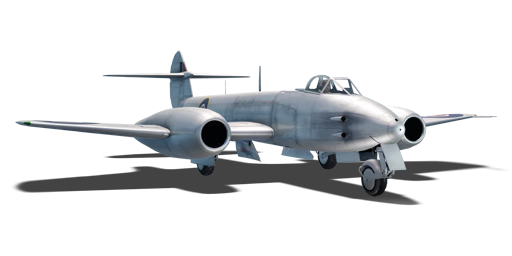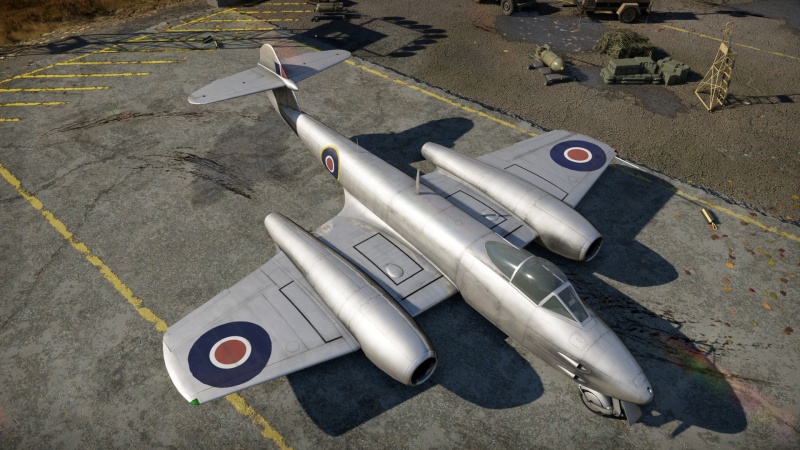Difference between revisions of "Meteor F Mk 4 G.41G"
m (→External links) |
(→Details: Corrected flap rip speed) (Tag: Visual edit) |
||
| Line 58: | Line 58: | ||
! Combat !! Take-off !! Landing !! + !! - | ! Combat !! Take-off !! Landing !! + !! - | ||
|- | |- | ||
| − | | {{Specs|destruction|body}} || {{Specs|destruction|gear}} || | + | | {{Specs|destruction|body}} || {{Specs|destruction|gear}} ||495||462||290 || ~10 || ~5 |
|- | |- | ||
|} | |} | ||
| Line 189: | Line 189: | ||
;Skins | ;Skins | ||
| + | |||
* [https://live.warthunder.com/feed/camouflages/?vehicleCountry=britain&vehicleType=aircraft&vehicleClass=jet_fighter&vehicle=meteor_fmk4_sw Skins and camouflages for the {{PAGENAME}} from live.warthunder.com.] | * [https://live.warthunder.com/feed/camouflages/?vehicleCountry=britain&vehicleType=aircraft&vehicleClass=jet_fighter&vehicle=meteor_fmk4_sw Skins and camouflages for the {{PAGENAME}} from live.warthunder.com.] | ||
| Line 197: | Line 198: | ||
;Related development | ;Related development | ||
| + | |||
* [[Meteor (Family)]] | * [[Meteor (Family)]] | ||
Revision as of 14:05, 17 February 2021
| This page is about the British jet fighter Meteor F Mk 4 G.41G. For other versions, see Meteor (Family). |
Contents
Description
The Meteor F Mk 4 type G.41G is a rank V British jet fighter with a battle rating of 7.7 (AB) and 8.0 (RB/SB). It has been in the game since the start of the Open Beta Test prior to Update 1.27.
General info
Flight performance
| Characteristics | Max Speed (km/h at 100 m) |
Max altitude (metres) |
Turn time (seconds) |
Rate of climb (metres/second) |
Take-off run (metres) | |||
|---|---|---|---|---|---|---|---|---|
| AB | RB | AB | RB | AB | RB | |||
| Stock | 905 | 887 | 12500 | 23.1 | 23.8 | 30.7 | 28.9 | 325 |
| Upgraded | 973 | 950 | 21.0 | 22.0 | 43.9 | 37.0 | ||
Details
| Features | |||||
|---|---|---|---|---|---|
| Combat flaps | Take-off flaps | Landing flaps | Air brakes | Arrestor gear | Drogue chute |
| ✓ | ✓ | ✓ | ✓ | X | X |
| Limits | ||||||
|---|---|---|---|---|---|---|
| Wings (km/h) | Gear (km/h) | Flaps (km/h) | Max Static G | |||
| Combat | Take-off | Landing | + | - | ||
| 0 | 390 | 495 | 462 | 290 | ~10 | ~5 |
| Optimal velocities (km/h) | |||
|---|---|---|---|
| Ailerons | Rudder | Elevators | Radiator |
| < 560 | < 600 | < 580 | N/A |
Engine performance
| Engine | Aircraft mass | |||||
|---|---|---|---|---|---|---|
| Engine name | Number | Empty mass | Wing loading (full fuel) | |||
| Rolls-Royce Derwent 5 | 2 | 5,516 kg | 207 kg/m2 | |||
| Engine characteristics | Mass with fuel (no weapons load) | Max Takeoff Weight | ||||
| Weight (each) | Type | 7m fuel | 20m fuel | 24m fuel | ||
| 443 kg | Centrifugal-flow turbojet | 5,888 kg | 6,539 kg | 6,739 kg | 6,940 kg | |
| Maximum engine thrust @ 0 m (RB / SB) | Thrust to weight ratio @ 0 m (100%) | |||||
| Condition | 100% | WEP | 7m fuel | 20m fuel | 24m fuel | MTOW |
| Stationary | 1,587 kgf | N/A | 0.54 | 0.49 | 0.47 | 0.46 |
| Optimal | 1,587 kgf (0 km/h) |
N/A | 0.54 | 0.49 | 0.47 | 0.46 |
Survivability and armour
- 38 mm Bulletproof glass in cockpit front.
- 12.7 mm Steel plate behind the pilot.
- 12.7 mm Steel plate in the nose.
- Critical components located at the front and wings of aircraft (fuel, pilot, engine, controls)
Modifications and economy
Armaments
Offensive armament
The Meteor F Mk 4 G.41G is armed with:
- 4 x 20 mm Hispano Mk.V cannons, nose-mounted (200 rpg top + 190 rpg bottom = 780 total)
Usage in battles
The Meteor has a fully air fighting role as the lack of ordnance and penetration for the 20 mm cannons make the aircraft useless for CAS or ground attack. The Meteor has 2 primary combat roles:
Bomber hunter:
The speed, acceleration, and firepower make this jet usable for bomber hunting. Pilots should use 30° climb to gain speed and altitude to be able to hunt bombers. Depending on the type of bomber that the Meteor encounters (jet bomber or prop bomber), tactics should vary.
For jet bombers:
Ar 234 B-2, Ar 234 C-3, IL-28 (all variants), etc, the pilot must try to use their agility to their advantage as most of them carry both offensive and defensive weaponry and sometimes will try to dogfight you (with exception of Ar 234 B-2 and B-57A). IL-28 should be approached carefully as the 23 mm offensive and defensive cannons can tear the Meteor apart with small bursts. Use your speed to your advantage.
For prop bombers:
B-29/Tu-4, etc, the pilot must use boom and zoom tactics as big planes lack agility but have powerful firepower. These aircraft should be approached as any other prop bomber (head-on or from below). Be aware of B-29 and Tu-4 as both have ventral turrets that will harm you, approach them in a head-on or in a frontal arc of 45° (blind spot for most turrets) or in a very steep angle from above (although this should not be the main angle of approach as both B-29 and Tu-4 have a turret elevation of 89°).
Air superiority fighter:
The Meteor, as with previous Meteors, is not a really fast aircraft but a competitive one. Boom-and-zoom against aircraft that are able to outturn you (Ho 229, Vampire FB 52A, etc), and turn against those that are able to outrun you (MiG-15).
Pros and cons
Pros:
- Good acceleration
- Reasonable top speed
- Clipped wings offer an improvement over the previous model in energy retention and wing durability
- Good at turning below 650 km/h
- Good climb rate
- Excellent ammo capacity for cannons (190 RPG for two of the cannons, 200 RPG for the other two)
Cons:
- Compression
- Loses manoeuvrability over 700 km/h significantly
- Limited visibility out of the rear of the cockpit
History
In-game description
In 1946 the Gloster Meteor F.Mk.4 was introduced; a variant intended to replace the F.Mk.3. The prototype F.Mk.4 flew for the first time on May 17th 1945; the new variant was powered by Rolls-Royce Derwent Mk.5 turbojet engines, producing 1,590 kg of thrust (more than twice as much as the Derwent Mk.1). The engines were fitted in new extended nacelles, which reduced drag, and a strengthened airframe design was incorporated to harness the increased power. Fitted with the new engines, the Meteor F.Mk.4 would go on to set two world air speed records in November 1945 and then again in September 1946.
Further modifications to the Meteor F.Mk.4 included its ailerons and adjustments to its rudder trim tab to reduce snaking. The cockpit was now fully pressurized and ventilated; previous versions of the Meteor had had a non-pressurized cockpit.
Trials of the prototype Gloster Meteor F.Mk.4 fighter showed that its maximum speed was increased by 180 km/h, but that this additional speed produced excessive stress on the wings. The wing panels, therefore, were made shorter from the ninth production aircraft onwards. This reduced the stress and improved horizontal manoeuvrability but reduced the rate of climb and the service ceiling. Type G.41F became the designation for the long-wing aircraft, and Type G.41G for the short-wing variant.
The Gloster Meteor F.Mk.4 represented a significant leap in terms of performance and was produced in large numbers, including as an export fighter. Based on the F.Mk.4, the two-seat T.Mk.7 trainer was developed.
By 1948 the F.Mk.4 had completely replaced the F.Mk.3 in the RAF and In May 1947, an export version was purchased by Argentina, followed by orders from Denmark, Egypt, Belgium and the Netherlands.
535 Gloster Meteor F.Mk.4 were produced for the RAF, with a further 168 aircraft being exported.
Media
- Skins
See also
- Related development
External links
- Official data sheet - more details about the performance
- [Wikipedia] Gloster Meteor
- [Air Vectors] The Gloster Meteor
| Gloster Aircraft Company, Limited | |
|---|---|
| Fighters | Gladiator Mk II · Sea Gladiator Mk I · Gladiator Mk IIF · Gladiator Mk IIS · Tuck's Gladiator Mk II |
| Jet Fighters | Meteor F Mk 3 · Sea Meteor F Mk 3 · Meteor F Mk 4 G.41F · Meteor F Mk 4 G.41G · Meteor F Mk 8 G.41K · Meteor F Mk.8 Reaper |
| Javelin F.(A.W.) Mk.9 | |
| Export | J8A · Iacobi's J8A · ␗Gladiator Mk I · ▄Gladiator Mk I |
| ▄Meteor F Mk.8 · Meteor F.8 · Meteor NF.13 | |
| See Also | Fokker |
| Britain jet aircraft | |
|---|---|
| Blackburn | Buccaneer S.1 · Buccaneer S.2 · Buccaneer S.2B |
| British Aerospace | Harrier GR.7 · Sea Harrier FRS.1 (e) · Sea Harrier FRS.1 · Sea Harrier FA 2 |
| British Aircraft Corporation | Strikemaster Mk.88 |
| English Electric | Canberra B Mk 2 · Canberra B (I) Mk 6 · Lightning F.6 · Lightning F.53 |
| Gloster | Meteor F Mk 3 · Sea Meteor F Mk 3 · Meteor F Mk 4 G.41F · Meteor F Mk 4 G.41G · Meteor F Mk 8 G.41K · Meteor F Mk.8 Reaper |
| Javelin F.(A.W.) Mk.9 | |
| de Havilland | Vampire F.B.5 · Venom FB.4 · Sea Venom FAW 20 · Sea Vixen F.A.W. Mk.2 |
| Hawker | Sea Hawk FGA.6 · Hunter F.1 · Hunter F.6 · Hunter FGA.9 · Harrier GR.1 · Harrier GR.3 |
| Panavia | Tornado GR.1 · Tornado GR.4 · Tornado F.3 · Tornado F.3 Late |
| SEPECAT | Jaguar GR.1 · Jaguar GR.1A · Jaguar IS |
| Supermarine | Attacker FB 1 · Attacker FB.2 · Scimitar F Mk.1 · Swift F.1 · Swift F.7 |
| Foreign | Phantom FG.1 (USA) · Phantom FGR.2 (USA) · F-4J(UK) Phantom II (USA) |
| Australia | F-111C |
| India | ▄MiG-21 Bison |
| South Africa | ▄JAS39C |





